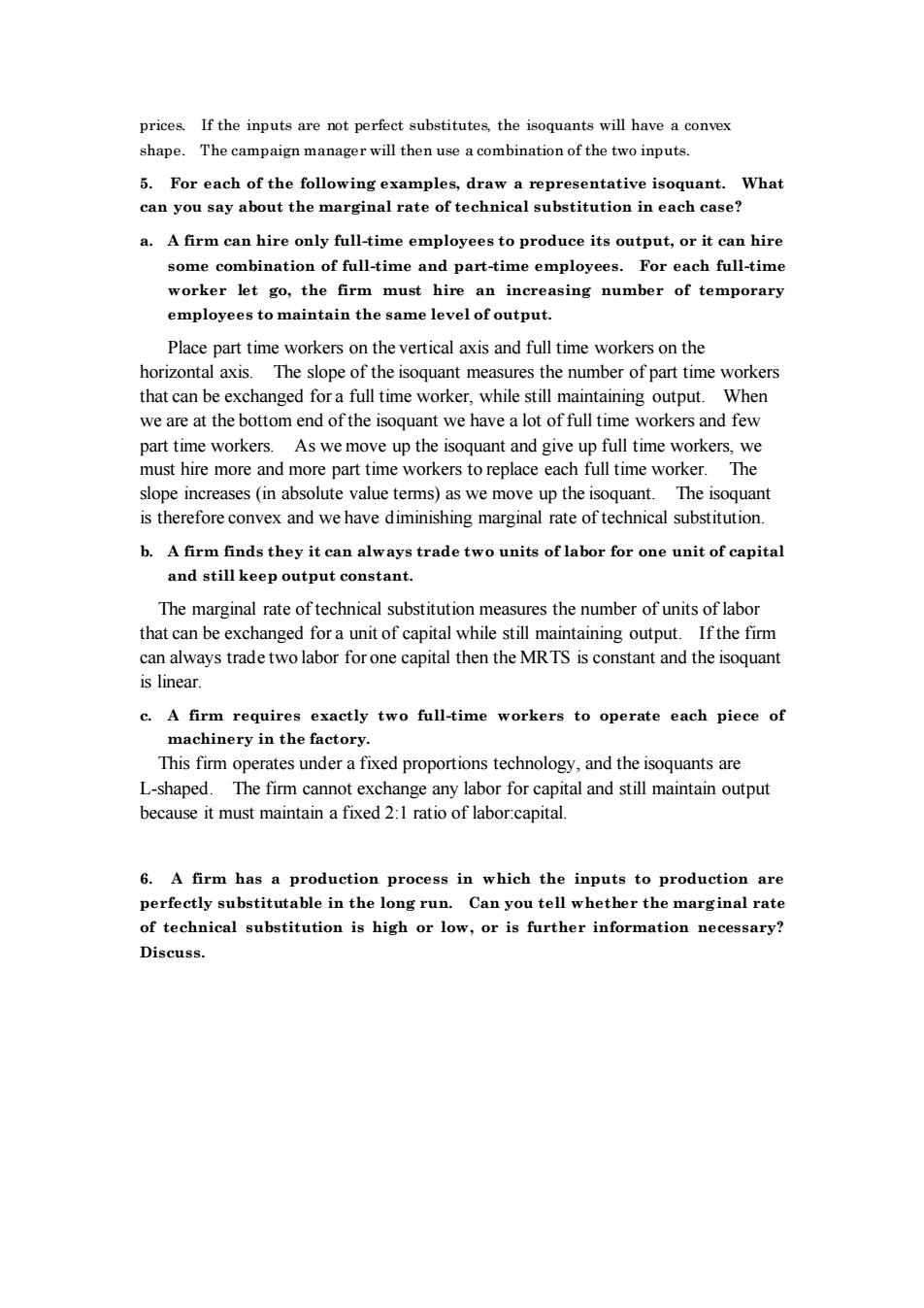正在加载图片...

prices If the inpuareopereetbtitute theill have shape.The campaign manager will then use acombination of the two inputs 5.For each of the following examples,draw a representative isoquant. What can you say about the marginal rate of technical substitution in each case? a.A firm can hire only full-time employees to produce its output,or it can hire some combination of full-time and part-time employees.For each full-time worker let go.the firm must hire an increasing number of temporary employees to maintain the same level of output. Place part time workers on the vertical axis and full time workers on the horizontal lope the isoquan t meas ures he nu of part time workers that can be exchanged for a full time worker,while still maintaining output. Wher we are at the bottom end of the isoquant we have a lot of full time workers and few part time workers.As we move up the isoquant and give up full time workers.we must hire more and more part time v workers to replace each full time worker.The slope increases(in abs mms)as we mo up the isoquan The isoquan is therefore convex and we have diminishing marginal rate of technical substitution. b.A firm finds they it can always trade two units of labor for one unit of capital and still keep output constant. The marginal rate of technical substitution measures the number of units of labor that can be exchanged for a unit of capital while still maintaining output.If the firm can always trade two labor for one capital then the MRTS is constant and the isoquant is linea c.A firm require s exactly two full-time workers to operate each piece of machinery in the factory. This firm operates under a fixed proportions technology,and the isoquants are L-shaped.The firm cannot exchange any labor for capital and still maintain output because it must maintain a fixed 2:1 ratio of laborcapital. 6.A firm has a production process in which the inputs to production are perfeetly substitutable in the long run.Can you tel whether the marginal rate of technical substitution is high or low,or is further info ormation necessary? Discuss.prices. If the inputs are not perfect substitutes, the isoquants will have a convex shape. The campaign manager will then use a combination of the two inputs. 5. For each of the following examples, draw a representative isoquant. What can you say about the marginal rate of technical substitution in each case? a. A firm can hire only full-time employees to produce its output, or it can hire some combination of full-time and part-time employees. For each full-time worker let go, the firm must hire an increasing number of temporary employees to maintain the same level of output. Place part time workers on the vertical axis and full time workers on the horizontal axis. The slope of the isoquant measures the number of part time workers that can be exchanged for a full time worker, while still maintaining output. When we are at the bottom end of the isoquant we have a lot of full time workers and few part time workers. As we move up the isoquant and give up full time workers, we must hire more and more part time workers to replace each full time worker. The slope increases (in absolute value terms) as we move up the isoquant. The isoquant is therefore convex and we have diminishing marginal rate of technical substitution. b. A firm finds they it can always trade two units of labor for one unit of capital and still keep output constant. The marginal rate of technical substitution measures the number of units of labor that can be exchanged for a unit of capital while still maintaining output. If the firm can always trade two labor for one capital then the MRTS is constant and the isoquant is linear. c. A firm requires exactly two full-time workers to operate each piece of machinery in the factory. This firm operates under a fixed proportions technology, and the isoquants are L-shaped. The firm cannot exchange any labor for capital and still maintain output because it must maintain a fixed 2:1 ratio of labor:capital. 6. A firm has a production process in which the inputs to production are perfectly substitutable in the long run. Can you tell whether the marginal rate of technical substitution is high or low, or is further information necessary? Discuss